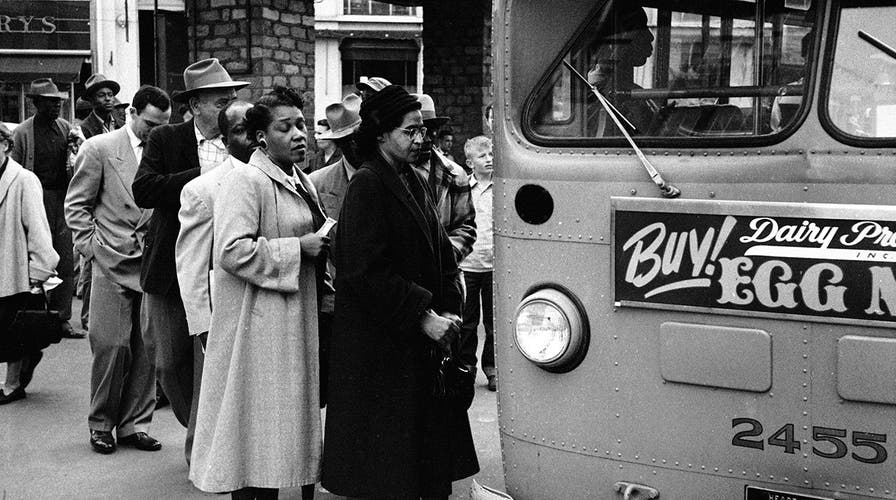Fox News Flash top headlines for February 16
Fox News Flash top headlines are here. Check out what's clicking on Foxnews.com.
The Montgomery bus boycott was a large civil rights demonstration that saw African Americans in the Alabama city refuse to ride public buses in protest of segregated seating.
Considered the first mass demonstration against segregation, the 381-day boycott began on Dec. 5, 1955, just days after Rosa Parks, a Black woman, was fined and arrested for refusing to give up her seat at the front of the bus to a White passenger.
ROSA PARKS: WHAT TO KNOW ABOUT THE 'MOTHER OF THE CIVIL RIGHTS MOVEMENT'
The boycott ended on Dec. 20, 1956, and led to the U.S. Supreme Court ruling that segregation on public buses was unconstitutional.

Rosa Parks sitting on a bus in Montgomery, Ala., in 1956. (Getty Images)
The boycott was a defining moment in the civil rights movement and helped thrust Martin Luther King Jr. and his commitment to nonviolent resistance into the spotlight.
Read on for more details on the events surrounding the boycott.
Rosa Parks was not the first African American to refuse to give up her seat
A 15-year-old girl, Claudette Colvin, was arrested on March 2, 1955 – nine months before Parks – for refusing to give up her seat aboard a Montgomery bus. While Black leaders in the city prepared to protest, they stopped short after discovering that Colvin was pregnant and believed she was not an appropriate figure for their cause, according to History.com.
In October of the same year, Montgomery resident Mary Louise Smith, 18, was also arrested and fined for refusing to give up her bus seat to a White passenger.

American civil rights activist Rosa Parks sits in the front of a bus in Montgomery, Alabama, after the Supreme Court ruled segregation illegal on the city bus system on Dec. 21, 1956. (Getty Images)
How Parks became the symbol for the movement was recounted in King's memoir "Stride Toward Freedom," in which he called her "ideal for the role assigned to her by history," according to the King Institute at Stanford University.
Parks' "character was impeccable and her dedication deep-rooted," King wrote, noting that she was "one of the most respected people in the Negro community."
Boycott was only supposed to last for a day
E.D. Nixon, president of the local NAACP, called for a one-day boycott of city buses on Dec. 5, 1955, following Parks' arrest. African American riders made up about 75% of the bus system’s passengers.
HARRIET TUBMAN: WHAT TO KNOW ABOUT THE UNDERGROUND RAILROAD ICON
After receiving unexpected publicity in local newspapers, radio and television, 90% of Black residents stayed off the buses that day.

American civil rights activist Rosa Parks (center, in dark coat and hat) waits to board a bus at the end of the Montgomery bus boycott, Montgomery, Alabama, Dec. 26, 1956. ((Photo by Don Cravens/The LIFE Images Collection via Getty Images/Getty Images))
The unexpected success led leaders to extend the boycott indefinitely. It ultimately lasted 381 days, or nearly 13 months, until Dec. 20, 1956, according to the King Institute.
Martin Luther King Jr. gains support
The success of the Montgomery bus boycott led to King’s election as president of the Montgomery Improvement Association in the hopes he would unite members of the Black community behind the civil rights cause.
King and many other boycotters, however, were victims of retaliation for their involvement in the demonstration. King's home was bombed and he was arrested, tried and convicted under a law against conspiracies that interfered with lawful business.
CLICK HERE TO GET THE FOX NEWS APP
The bus boycott and King’s trial received national media attention and resulted in more support from people outside of Montgomery.




